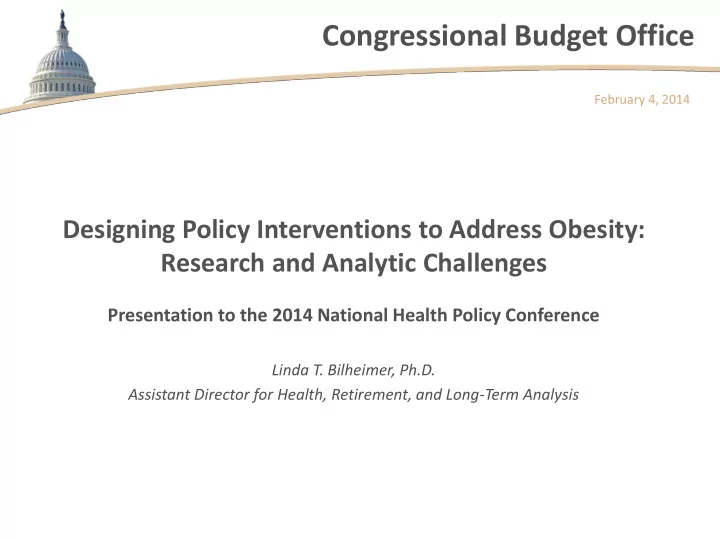

Congressional Budget Office February 4, 2014 Designing Policy Interventions to Address Obesity: Research and Analytic Challenges Presentation to the 2014 National Health Policy Conference Linda T. Bilheimer, Ph.D. Assistant Director for Health, Retirement, and Long-Term Analysis
Defining, Measuring, and Projecting Obesity Alternative measures of obesity associated with different health risks/degrees of risk: – Body mass index (BMI) • Easiest to measure and self-report, but subject to reporting error • Sometimes misleading : Elderly people? Racial and ethnic subpopulations? – Body fat percentage – Central adiposity (excess abdominal fat) • More relevant for elderly people? Duration matters recent focus on “obesity years”: – Challenging to measure due to recall bias, few longitudinal studies Issues with projecting future obesity prevalence: – Weighting recent vs. historical trends – Projecting BMI categories vs. shifts in BMI distribution – Incorporating duration C O N G R E S S I O N A L B U D G E T O F F I C E
Effects of Obesity on Health Risk factor for: – Multiple chronic conditions – Adverse pregnancy outcomes – Disability – Dementia? – Mortality — protective effects for elderly? Challenges of isolating effects: – Competing health risks – Variation across lifespan – Effects of prior obesity years – Varying relationships between effects and measures – Changing relationships over time – Variation among population subgroups C O N G R E S S I O N A L B U D G E T O F F I C E
Effects of Obesity on Health Care and Disability Costs Wide variation in estimates of: – Health care costs attributable to obesity – Effects on subsequent costs of: • Preventing obesity among populations at risk • Intentional weight loss among obese people Challenges of isolating effects and specifying counterfactuals: – Competing health risks – Other individual characteristics with independent effects on costs – Non-linearity; concentration of additional costs among severely obese – Reverse causality Effects on payers: – Dependence on prevalence of obesity/severe obesity, and varying effects, among population subgroups – Interactions of longevity and disability effects: Implications for Medicare and Medicaid C O N G R E S S I O N A L B U D G E T O F F I C E
Assessing Effects of Interventions (for Prevention and/or Mitigation) Different types of interventions different evaluation questions and research issues: – Clinical interventions for individuals: behavioral, pharmaceutical, surgical, combinations – Interventions targeting defined groups: community-, school-, or employment-based – Interventions targeting populations: laws and regulations, excise taxes Issues with evaluation studies: – Methodological weaknesses – Wide ranges of conclusions – Publication biases Challenges for systematic reviews: – Weighting older studies C O N G R E S S I O N A L B U D G E T O F F I C E
Evaluating Interventions Targeting Individuals or Defined Groups: Internal Validity Does intervention improve health and/or reduce costs of participants ? – What is basis for comparison? • Randomized controlled trials vs. observational comparison groups • Addressing observed and unobserved differences with observational comparison groups – How are outcomes measured? • Intermediate measures: weight, biomarkers • Health status measures: chronic conditions, disability, mortality • Health care costs: challenges of small sample sizes and high-cost cases – How is confounding addressed? • Smoking, physical activity, comorbidities, socioeconomic status, etc. – What time frames are considered? • Focus on relatively short-term intermediate outcomes • Inferences for longer-term health status outcomes (given difficulty of maintaining weight loss/healthy behaviors) – How is attrition accounted for? • Intent-to-treat vs. completers • Imputation methods for non-completers C O N G R E S S I O N A L B U D G E T O F F I C E
Evaluating Interventions Targeting Individuals or Defined Groups: External Validity How generalizable are findings to broader population and to everyday practice? ‒ How is sample selected? • Representativeness of people eligible to participate — of overall population and key subgroups • Differences between participants and nonparticipants (among those eligible) ‒ How should findings from controlled clinical studies be used? • Efficacy vs effectiveness in everyday practice • Converting from clinical to community-based interventions C O N G R E S S I O N A L B U D G E T O F F I C E
For Further Information linda.bilheimer@cbo.gov 202/226-2676 C O N G R E S S I O N A L B U D G E T O F F I C E
Recommend
More recommend